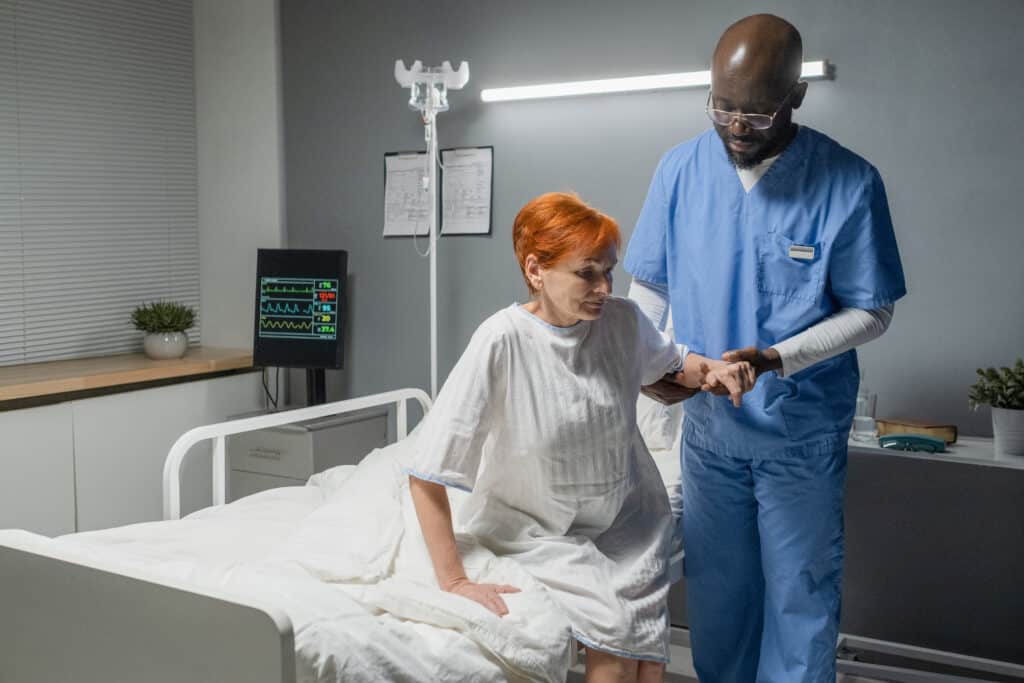Aging gracefully often comes with its fair share of challenges. Among these are the persistent neck and back aches that no number of massages or over-the-counter painkillers seem to alleviate. For some more serious cases, the proposed solution, often seen as a last resort, is spinal fusion surgery.
Spinal fusion surgery is a major procedure that involves joining two or more vertebrae in your spine with bone grafts, screws, rods, or plates. The main goal of spinal fusion surgery is to stabilize your spine, relieve pain, and improve your overall function.
This article draws from my extensive experience as a physical therapist helping patients recover from these procedures. Let me walk you through this process and everything you can expect to encounter during your recovery process.
The Basics of Spinal Fusion Surgery
In simple terms, consider your spine as a stack of building blocks. Imagine if two or more of these blocks continuously shifted and caused discomfort. Spinal fusion is the process of securing these problematic blocks together. This procedure uses bone grafts, screws, rods, or plates to ensure stability, alleviate pain, and enhance movement.
These bone grafts can come from your own body (autograft) or a donor (allograft). Surgeons may also use strong screws or rods, often made of resilient metals or high-grade plastics, to keep everything in place as the bone grafts fuse.
Who Might Need Spinal Fusion?
Spinal fusion surgery mainly aims to stabilize your spine, relieve pain, and improve function. I have seen many patients undergo spinal fusion surgery for several conditions, including:
- Degenerative disc disease is when the discs between your vertebrae lose their cushioning and elasticity over time, causing them to wear out and collapse. This can lead to pain, stiffness, and loss of function in your spine.
- Spinal stenosis is when the space around your spinal cord or nerve roots narrows due to bone spurs, thickened ligaments, or disc injury. This can cause pain, numbness, tingling, or weakness in your arms or legs.
- Scoliosis is a condition where the curvature of your spine develops abnormally. This can cause pain, deformity, and even breathing problems.
- Spondylolisthesis is a condition where one vertebra slips forward over another vertebra. This can cause pain, instability, and nerve compression in your spine.
- Spinal fractures are cracks or breaks in your vertebrae due to trauma or excess stress. These can cause severe pain and loss of function in your spine.
It’s worth emphasizing that spinal fusion surgery isn’t a go-to option. It’s typically recommended only when other treatments like physical therapy or less invasive procedures don’t yield desired results.
Charting the Recovery Process

Recovery from fusion surgery isn’t a one-size-fits-all narrative. Various factors come into play, including the complexity of the surgery, an individual’s age, and their overall health and physical condition. However, let’s sketch out a general recovery timeline for commonly experienced after-effects.
Stage 1: The Initial Week Post-Surgery
This week is critical to making sure your spinal fusion is a success. While the surgery’s immediate aftermath can be quite painful, the focus here is on effective pain management and kick-starting mobility.
You’d typically spend a day or two in the hospital, beginning gentle physical therapy and ensuring proper incision site healing. Your physical therapist will teach you how to get in and out of bed, sit, stand, and walk safely with or without assistance. You will also learn a few exercises to improve your strength and endurance during your initial recovery.
You will be discharged from the hospital when you can walk independently, manage your pain with oral medication, and perform basic activities with minimal assistance. Of course, you will need someone to drive you home and help you with household chores for the first few weeks. At this stage, you must also follow some precautions at home, such as keeping your incision site clean and dry.
Many of my patients report high pain levels during this stage and require a very high level of assistance from a caregiver. This type of surgery is particularly invasive, so it makes sense that your body needs significant time to recover.
Stage 2: Weeks 2 to 6
This phase is all about steady progression. Under the guidance of a physical therapist, you’ll work on regaining strength, flexibility, and balance.
You will gradually resume some daily activities and increase your physical activity level. You will continue physical therapy at an outpatient clinic and begin performing progressive exercises at home according to your therapist’s instructions.
During physical therapy, you will learn more advanced exercises to improve your core stability, posture, balance, and endurance. You will also receive proper body mechanics, ergonomics, and spine care education.
While you might not expect to need these treatments, many of my patients experience loss of their normal strength and coordination after surgery. So, taking these treatments seriously early to regain function fully is essential.
Depending on your job and recovery progress, you can return to work at a limited capacity after 4 to 6 weeks. Limited capacity can resemble modifications or accommodations at work or school, such as shorter hours, lighter duties, or more ergonomic equipment.
At this stage, avoid strenuous or high-impact activities that may stress your spine, such as running, jumping, lifting heavy objects, or playing contact sports.
Stage 3: Weeks 7 to 12 Post-Surgery
This is the stage where you start to notice real recovery and return to many of your regular pre-surgery activities. During this phase, you will continue physical therapy and experience improved strength, flexibility, and mobility in your spine.
Some of my patients are able to start experimenting with low-impact versions of their recreational activities that do not involve excessive bending, twisting, or impact.
For example, you may be able to swim gently, bike on an upright bike, or go on a low-intensity hike. However, you should continue avoiding activities that may cause excessive stress or trauma to your spine, such as skiing, snowboarding, horseback riding, or martial arts.
Most of the healing in your body will happen in the first three months after surgery. For this reason, you should have a follow-up visit with your surgeon around 12 weeks (3 months) after surgery.
Your surgeon will evaluate your recovery progress and perform some tests to check the stability and fusion of your spine. Your surgeon can also advise you on any permanent restrictions or precautions you must follow based on your spine’s healing after surgery.
Stage 4: Week 13 and Onwards
Around week 13, changes will become minor and incremental, but you will begin to notice the benefits of your hard work. At this stage, most of your improvements with pain will have taken place, and you should be able to enjoy a higher quality of life. At this stage, many of my patients can perform daily activities and participate in many social or leisure activities with relatively few limitations.
Of course, you should still take good care of your spine and continue diligently with your rehabilitation over the next several months (remember, full recovery can take 1-2 years).
Some principles that I educate my patients on during the later phase of their recovery include maintaining a healthy weight, eating a balanced diet, staying hydrated, exercising regularly, avoiding smoking and alcohol, and progressing activity slowly.
Now that we’ve covered the timeline for recovery after spinal fusion surgery, let’s dive into the overall recovery process considerations.
The Main Components of Spinal Fusion Recovery

Because spinal fusion surgery recovery is complicated, I often spend a lot of time educating my patients on a few crucial components that will be paramount to their success: physical therapy, activity restrictions, and pain management.
Let’s dive into each of these essential components of recovery:
Physical Therapy
Physical therapy is an essential part of your recovery process after spinal fusion surgery to help restore your mobility, strength, flexibility, posture, and endurance.
Research shows that physical therapy is one of the most effective treatment methods for spinal fusion recovery for improving strength, reducing pain, and boosting your overall quality of life.
Most of my patients do a combination of physical therapy at home and at an outpatient clinic, which may vary slightly based on your surgeon’s recommendation. The duration and frequency of your physical therapy sessions will depend on your level of independence and recovery progress. Still, you can expect to have physical therapy sessions roughly twice weekly for the first 6 to 12 weeks after spinal fusion surgery.
With progress, you’ll need fewer clinical therapy sessions. However, having an exercise plan is essential to continue progressing and ultimately return to your favorite activities.
I always inform my patients that physical therapy doesn’t have to be in the clinic. Still, it should be a constant process of continuously staying active and making incremental progress with your physical abilities after surgery.
Activity Restrictions
Activity restrictions may vary depending on the specifics of your spinal fusion surgery. However, some general activity restrictions that you need to follow after spinal fusion surgery include:
- Avoid bending, twisting, or lifting anything heavier than five pounds for several weeks after surgery. This includes vacuuming, laundry, gardening, or carrying groceries. You may use a grabber or a reacher to pick up objects from the floor or shelves, but keeping your maneuvering and lifting to a minimum is essential.
- Avoid driving for 1-2 months after surgery or until your surgeon clears you. You may ride as a passenger in a car, but you should limit the travel time to less than 30 minutes at a time. There are lumbar support pillows available that you can use to support your spine better while sitting in a car.
- Avoid sitting for long periods after surgery, and change your position frequently. One method I teach my patients is to set timers and walk around every hour to prevent stiffness in their back.
- Avoid sleeping on your stomach as much as possible for several weeks after surgery. You may sleep on your back or side, but using pillows to support your body correctly is essential. You may also use a pillow between your knees if you sleep on your side or under your knees if you sleep on your back.
Activity restrictions can help prevent complications or damage to your spine and fusion site. If you previously lived a high-energy, active lifestyle, it can be easy to do “too much too fast” and slow your progress.
However, activity restrictions are not meant to keep you inactive or sedentary. You should gradually increase your physical activity level as you recover from the surgery day after day—just be sure to follow the guidelines from your surgeon and physical therapist.
Pain Management
Pain management is another critical element of your recovery after spinal fusion surgery. It will help you keep your pain under control, reduce inflammation, and improve your comfort. Effective pain management can also help you prevent or reduce the risk of chronic pain, medication dependence, and pain-related depression.
The type and amount of pain medication you need after spinal fusion surgery depends on factors such as your medical history and pain tolerance. You can generally expect to use different types of pain treatment during your recovery.
Oral pain medication is any medication taken by mouth as pills or liquids. You may receive oral pain medication after being discharged from the hospital, such as opioids, non-steroidal anti-inflammatory drugs (NSAIDs), acetaminophen, or muscle relaxants.
Carefully follow your doctor’s prescription and instructions on how to take your oral pain medication. All drugs have side effects; report concerns such as constipation, drowsiness, stomach upset, or substance dependence to your doctor.
Topical pain medication is applied directly to your skin in creams, gels, patches, or sprays. You may be given topical pain medication as an alternative or supplement to your oral pain medication, such as lidocaine, menthol, or diclofenac.
While topical pain medications are generally well-tolerated and can be purchased over the counter, I always educate my patients on the importance of clearing any new medicines with their doctor before use.
Non-pharmacological pain management includes techniques not involving taking or applying drugs to manage your pain.
There are several types of non-pharmacological pain management, like ice or heat therapy, massage, electrical stimulation therapy, acupuncture, and meditation. You should consult your doctor or physical therapist before using non-pharmacological pain management methods or techniques.
Comprehensive pain management after spinal fusion surgery is supported by scientific evidence to improve outcomes and reduce unwanted side effects during treatment. Many patients prefer certain medications or non-pharmacological pain management approaches, so talking with your doctor about what works best for you is the best approach.
Key Takeaways
- Spinal fusion surgery is a major procedure that involves joining two or more vertebrae in your spine with bone grafts, screws, rods, or plates. Spinal fusion surgery aims to stabilize your spine, relieve pain, and improve your function.
- The recovery after spinal fusion surgery is a long and challenging process that requires patience, perseverance, and commitment. Your recovery time after spinal fusion surgery can range from months to years, depending on several factors.
- The outcome of spinal fusion surgery depends on many factors, such as the type and extent of the surgery, your condition before surgery, and your adherence to the post-operative instructions and rehabilitation program.
- Spinal fusion surgery is not a decision that should be taken lightly. Carefully weigh the pros and cons of spinal fusion surgery and discuss them with your doctor and physical therapist. It’s also important to explore conservative treatments, minimally invasive procedures, and lifestyle changes before committing to surgery.
FAQ’s
How long does spinal fusion surgery take?
The duration of spinal fusion surgery depends on several factors, such as the number and location of the fused vertebrae, the type and extent of the surgery, and any complications. In general, spinal fusion surgery can take 2 to 6 hours.
How long do I have to wear a brace after spinal fusion surgery?
The need and duration of wearing a brace after spinal fusion surgery depend on several factors, such as the location of the fusion and the stability of your spine. You can expect to wear a brace for 6 to 12 weeks after spinal fusion surgery. Your doctor or physical therapist will advise you on how to wear, adjust, and care for your brace.
When can I shower or bathe after spinal fusion surgery?
You can shower or bathe after spinal fusion surgery when your incision site is completely healed and dry and when your doctor permits you. This can take a few weeks to occur after surgery. Avoid soaking your incision site in water, such as in a bathtub, hot tub, or swimming pool, until you have been cleared.
When can I exercise after spinal fusion surgery?
After spinal fusion surgery, you can exercise when your doctor or physical therapist permits. This varies heavily depending on your condition before surgery and overall recovery progress. You can gradually increase your exercise intensity and duration as you recover from the surgery if you follow your doctor’s and physical therapist’s guidelines and recommendations.
References
- Kernc D, Strojnik V, Vengust R. Early initiation of a strength training based rehabilitation after lumbar spine fusion improves core muscle strength: a randomized controlled trial. J Orthop Surg Res. 2018 Jun 19;13(1):151. doi: 10.1186/s13018-018-0853-7. PMID: 29914580; PMCID: PMC6006840.
- Wang P, Wang Q, Kong C, Teng Z, Li Z, Zhang S, Sun W, Feng M, Lu S. Enhanced recovery after surgery (ERAS) program for elderly patients with short-level lumbar fusion. J Orthop Surg Res. 2020 Aug 6;15(1):299. doi: 10.1186/s13018-020-01814-3. PMID: 32762762; PMCID: PMC7409683.
- Tarnanen S, Neva MH, Kautiainen H, Ylinen J, Pekkanen L, Kaistila T, Vuorenmaa M, Häkkinen A. The early changes in trunk muscle strength and disability following lumbar spine fusion. Disabil Rehabil. 2013 Jan;35(2):134-9. doi: 10.3109/09638288.2012.690496. Epub 2012 Jun 7. PMID: 22671313.
- Hermansen A, Hedlund R, Zsigmond P, Peolsson A. A more than 20-year follow-up of pain and disability after anterior cervical decompression and fusion surgery for degenerative disc disease and comparisons between two surgical techniques. BMC Musculoskelet Disord. 2023 May 22;24(1):406. doi: 10.1186/s12891-023-06503-w. PMID: 37217867; PMCID: PMC10201763.








